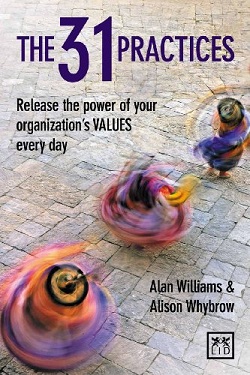Title: The 31 Practices – release the power of your organization’s values everyday
Authors: Alan Williams & Alison Whybrow
ISBN: 978-1907794353

This book was reviewed by David Evans of Burn Bridge Associates.
This book has credibility, intrigue and is a window on the world we live in. This much we learn from the opening dedication – “we dedicate this book to the alchemy of relationships, curiosity and serendipity” – and the fact that the Forward is written by Richard Barrett. Indeed, it is Barrett who describes the text as an “encyclopaedia of understanding about what it takes to build the neural pathways of an organisation.”
At the heart of its 31 chapters, the book is essentially about authenticity; about the shift from product-based reputation to service- and people-centric reputation … as a former consumer-goods marketer and now occupational behaviourist, this is core-reading for me! And, it is about the ‘how’ of what we do at work, in support of all the normal goal-setting and performance-management tools and techniques already embedded in the organisation.
As Barrett implies in the quote above, it is also very much a reference book: the chapters are bite-sized, which makes this an easy pick up / put down tome. Furthermore, each chapter concludes with a “want to know more?” panel, offering further reading.
So, what about these 31 practices? Well, the concept of developing 31 values-based practices that can be adopted and practised by your employees – one for each day of the month – originates from around 20 years of experience in supporting businesses in the area of customer service and brand-building. The need for these practices perhaps reflects the recent seismic shifts in the world of work; partially resulting from the growth in technology as an enabler to trading and operational effectiveness, partially from the increasing sophistication in consumer understanding; and partially from the fact that an organisation’s stakeholders increasingly control the perception of that entity, not the organisation itself (for example, for customers the least senior people have the greatest influence in forming perceptions about the entity).
If you accept all of that, then enduring organisational success is firmly embedded in its core values. Values, deeply-held beliefs that reflect what is important to us and what motivates us, define how organisations are perceived and experienced by their stakeholders. They are a “behavioural and decision-making compass” (Rosanna Fiske, quoted by the authors). The purpose of the 31 practices is to enable people in organisations to reconnect with what is at the core, to promote authenticity and consistently-high positive performance at work and to facilitate individual well-being.
After a comprehensive introduction, the authors move on to a discussion about purpose: they argue that unless there is a compelling purpose (the ‘what’), the values (the ‘how’) are pretty much redundant. Selecting the most appropriate organisational purpose means that entities can ride out periods of turbulence in a way that less-grounded organisations cannot. Interestingly, the examples given (p.65-66) by the authors of organisational purpose focus on employee, rather than on customer; the logic being that an energised and focussed employee will naturally look after and delight the customer.
There follows a number of sections that cover the development and implementation of values in support of the purpose. These are practical in nature, giving the practitioner-reader the opportunity to take away tools for deployment in the organisational context. They draw on the work done by Richard Barrett’s Values Centre on the seven levels of organisational consciousness. And they look at the measurement and refinement of the values as they transition from concepts into the 31 practices.
Part 3 of the book looks at the underlying principles that give the 31 practices their robustness – these are discussed under the three headers of heart, mind and body; the emotional (which deals with emotions, inspiration and happiness), the mind’s inner landscape (mindfulness, resilience and storytelling) and the physical (practice, strengths and discipline). This section of the book is incredibly powerful, personalised and instructive. I found the contents both reinforcing of the things I already knew and informative with new knowledge. It focusses on the individual as the key unit of effect in the delivery of organisational excellence, and it is a precursor to section 4’s attention on the broader context of the organisation.
The fourth part of the book deals with some big topics – complexity, change, wisdom, neuroscience, choice and leadership. These are covered with useful summaries on the latest thinking for each topic, made accessible and practical.
In the fifth section, the authors provide additional case studies to show how the development and application of the 31 practices can benefit organisations. Furthermore they demonstrate that the approach can be individualised for personal development and performance.
Reviewer’s rating
Anything that involves Alison Whybrow is normally good, in my experience. She has been a leading light in the world of Occupational Psychology for a number of years now and is an authority in the world of coaching and personal performance-improvement.
This is a great reference book for those in organisations seeking to bring some meaning and order to the ever-changing world of work. It is not, strictly speaking, a book that will change one’s perception of the role of HR and make the daily work of an HR professional any easier or more exciting. However, as a framework for fundamental organisational change; as a ‘How to’ guide for someone wishing to bring order into their life; as a reminder of what’s possible in our complex world – this is a must-read.
Finally, any book about organisational development and competitive excellence that quotes AA Milne (“you’re braver than you believe, and stronger than you seem, and smarter than you think” – p.160) and JK Rowling (“it’s our choices that show what we truly are, far more than our abilities” – p.257) has to be worth giving some attention to!
Rating: 5 out of 5






